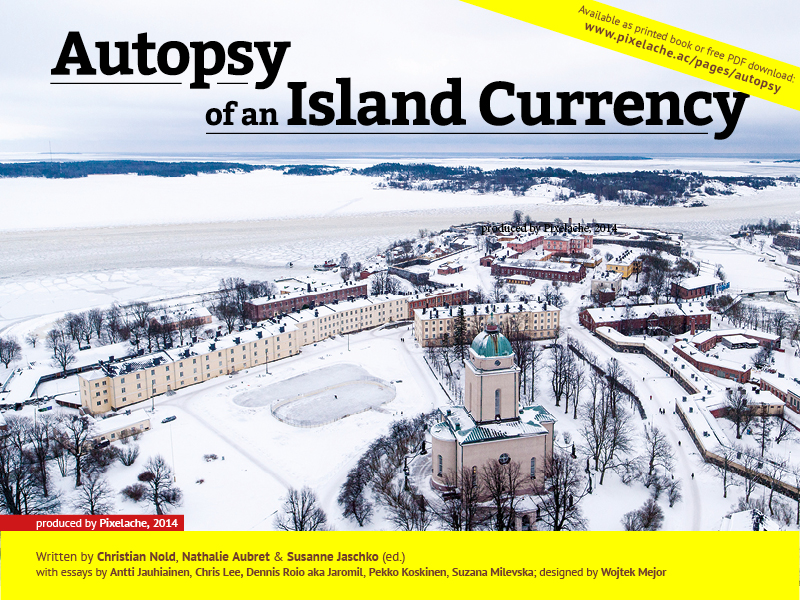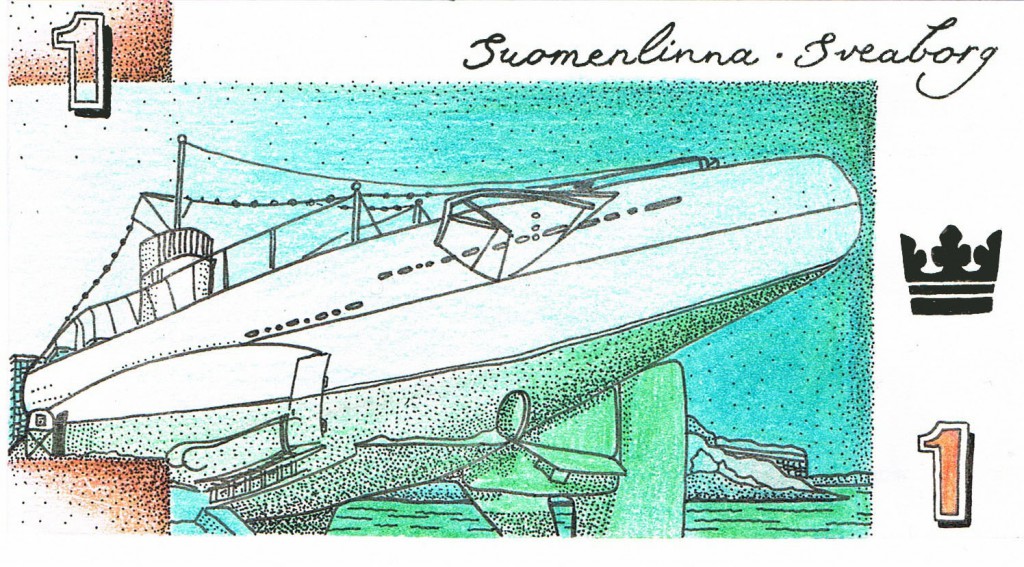A project by Christian Nold in collaboration with Susanne Jaschko and Pixelache
Suomenlinna, Helsinki, Finland, 2010 – 2013
Autopsy of an Island Currency, publication, 2014
Image: competition winning design of 1 Kuula by Hilla Mäkelä
The Suomenlinna Money Lab was an artistic research project that took place in Helsinki, Finland, from April 2010 to August 2013. It tried to create an experimental local currency for the small island of Suomenlinna. The general aim of the Money Lab was to engage with the specifics of a local setting by working with local people and creating a project that would generate interesting research and be beneficial to local dynamics. It was an ambitious attempt to explore and affect a unique place and its social dynamics through participatory art and design practice.
The project was initiated by Susanne Jaschko, commissioned and produced by Pixelache, a cultural organisation in Helsinki, who together invited artist Christian Nold to develop a project for Helsinki. Christian Nold’s way of working combines art and design and is related to ‘Critical Design’. The design part is an attempt to create tangible ‘solutions’ to real world issues, while the art part is an idiosyncratic way to identify and engage issues and contexts.
After considering several neighbourhoods in Helsinki, the project settled on the island of Suomenlinna — a very special place with about 800 permanent residents, which is protected as a UNESCO heritage site and receives 650,000 visitors every year. Nold did not come to the island with a preconceived concept of what the project should be. The approach was to meet key local actors of the island and conduct a series of public workshops open for anyone to join. The project team wanted to get a better sense of the island and start discussions about what kind of project to set up.
From these first meetings the idea evolved to focus on ‘local money’ as a social medium for people and a localised object that shapes and represents a geographical place. The workshops investigated different ways that the social and geographical combine to create ‘local value’. The project was supposed to culminate in a local currency, but one problem was that only a small number of enthusiastic individuals came to the brainstorming events. The currency could only be implemented through some firm local commitment, which would involve the transaction of ‘real money’ being exchanged into a local currency and back again. These aspects had a seriousness that required mutual trust and a commitment from local shops to accept and exchange the local currency. While there were certain groups of people on the island such as the Community Association, craftspeople and artists that were enthusiastic and saw the value of the currency, the Money Lab team encountered difficulties with the complex power structures of the island. Apart from the local Community Association, the project had little official support and was affected by opposition from the Governing Body and certain individuals. Next to a children’s workshop on money design, the project entailed a design competition for the local currency. In a public pole, Kuula (Finnish for ‘cannonball’) was chosen as the name of the currency.
In the course of time it became clear that there would not be enough long-time commitment by the people of Suomenlinna to realise a fully functioning currency. The project team decided to stop working into this direction and to focus instead on the documentation of the project. The result is the publication ‘Autopsy of an Island Currency’, which describes the project’s process in detail trough a combination of first-person narration and ‘artefacts’, a wide selection of documented materials in the form of emails, notes, sketches, announcements and reflections. It was published in June 2014 as printed book and free PDF. The publication does not only document the project, but analyses its problems, such as the internal social dynamics and power structures on the island, which the Suomenlinna Money Lab project rendered visible. In addition, commissioned essays by authors such as Suzana Milevska, Jaromil, Chris Lee and others contextualise the project and discuss subjects such as the challenges of participatory art, the value and hybrid nature of participatory projects, and alternative money systems. As such, it should be a valid source of information for anybody who wants to set up a local alternative currency or participatory project that requests a high degree of people’s commitment. You can download the free PDF of the book here.

 Blog
Blog